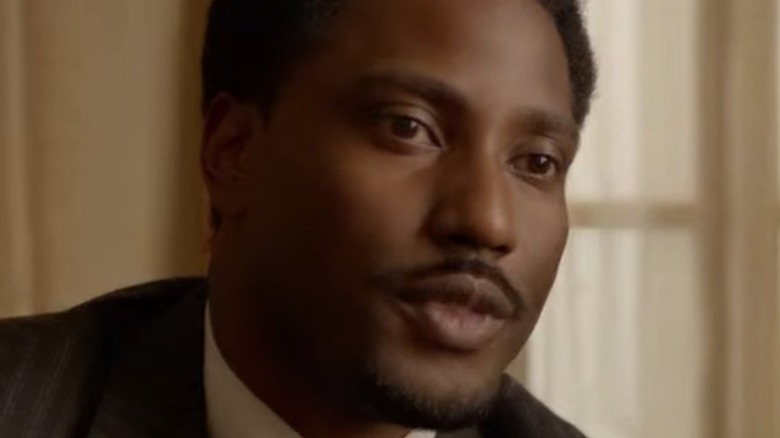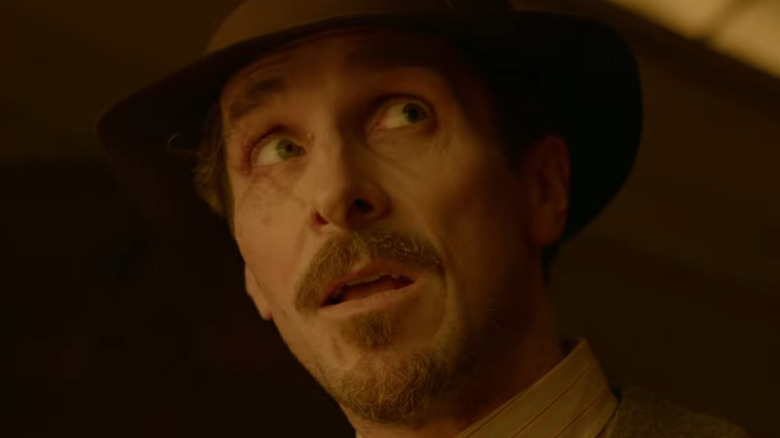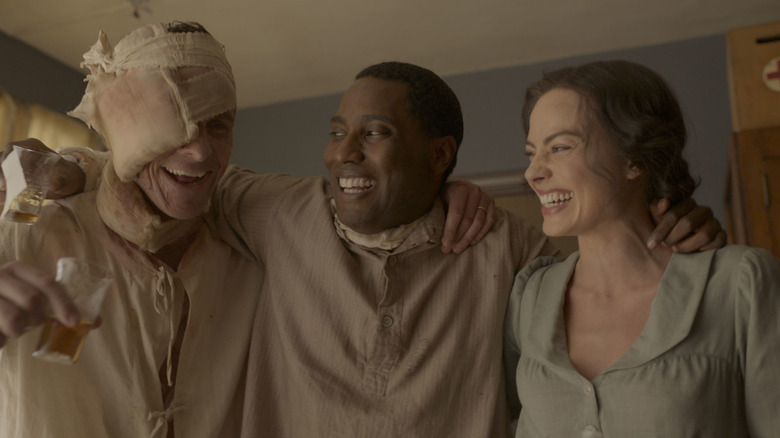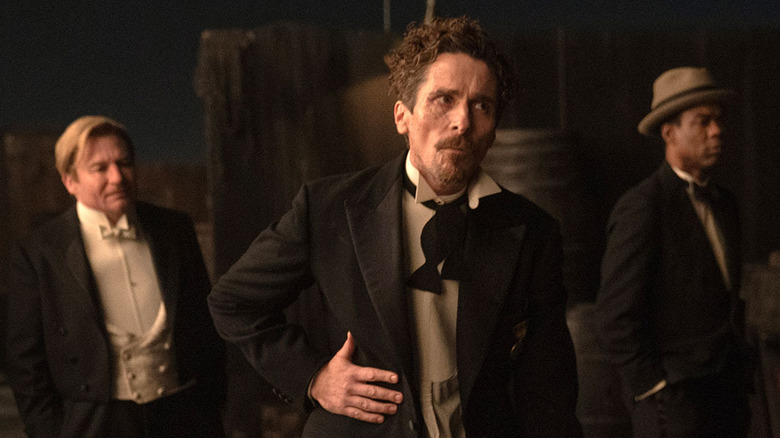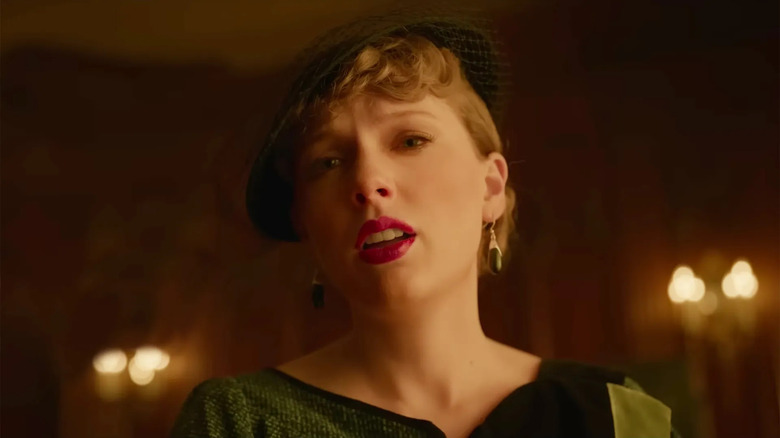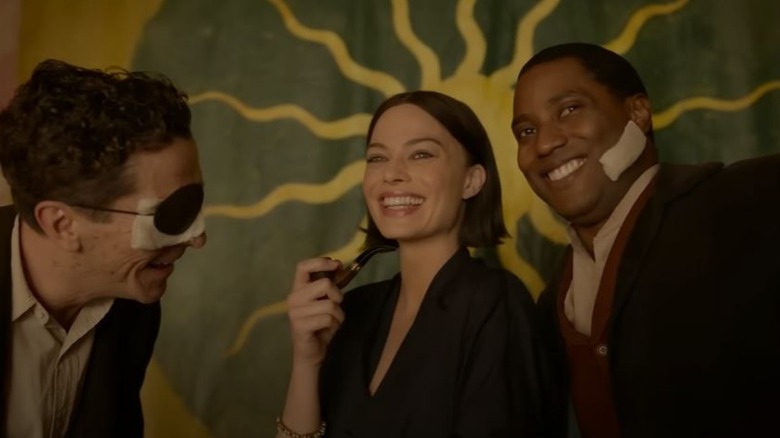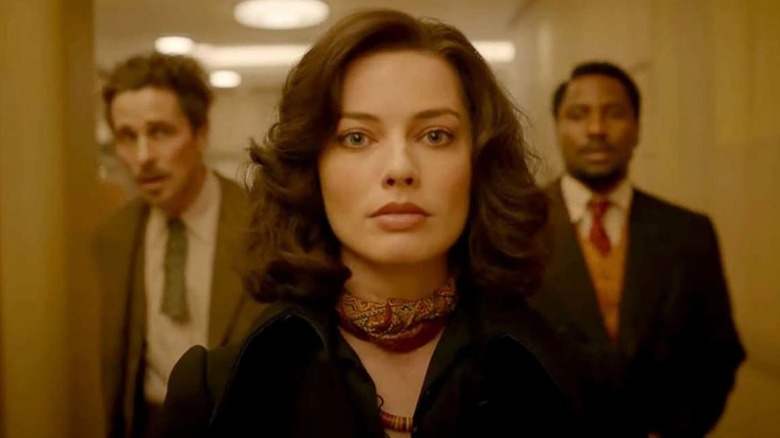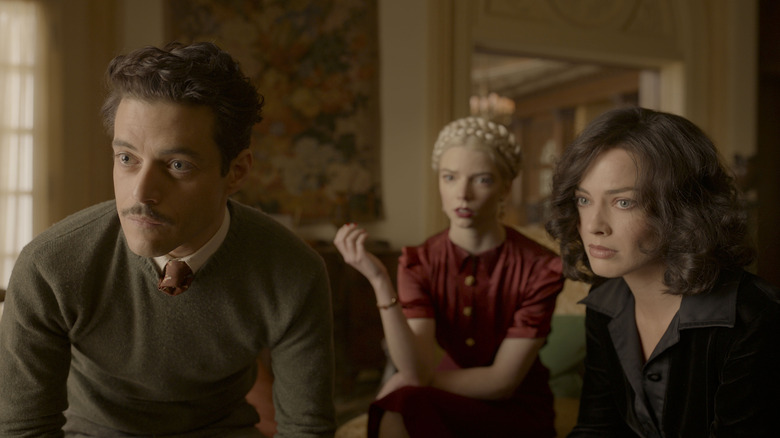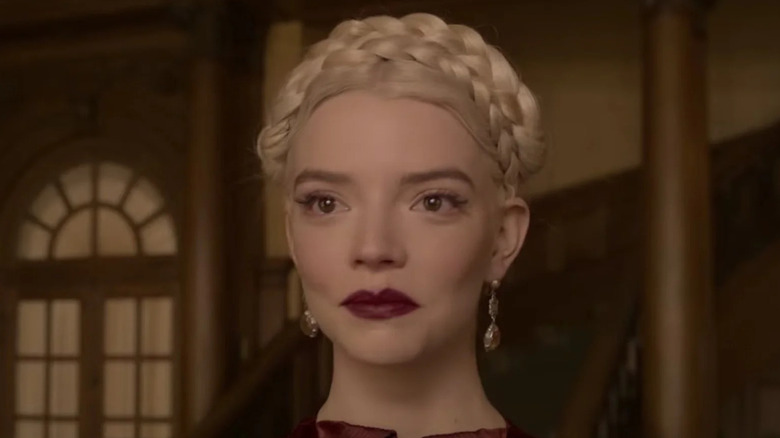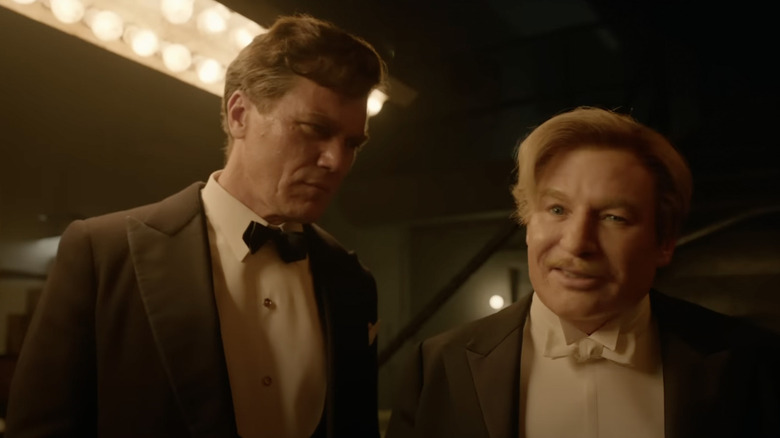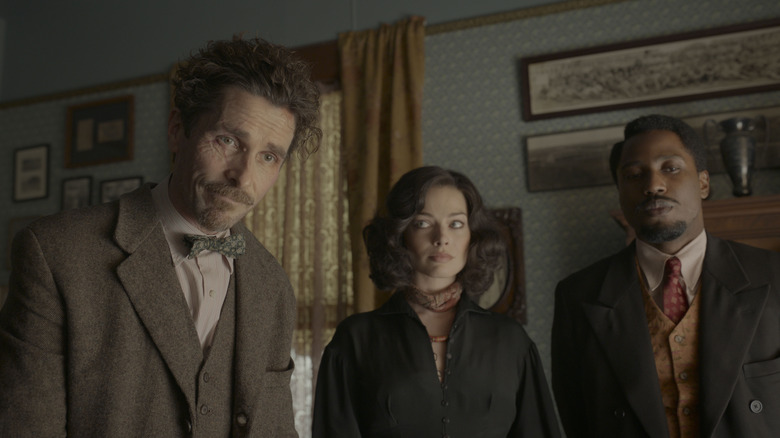Biggest Unanswered Questions In Amsterdam
"Amsterdam" is the latest film by Academy Award-nominated writer-director David O. Russell. Like his previous works "American Hustle" and "I Heart Huckabees," "Amsterdam" boasts a massive all-star cast. Led by Christian Bale, Margot Robbie, and John David Washington, the film also features appearances by Robert De Niro, Zoe Saldana, Anya Taylor-Joy, Rami Malek, and Taylor Swift. With a cast this stacked, it's easy for a film like "Amsterdam" to feel pretty overcrowded.
The complex plot is similarly crowded, as critics have noted. The film's lead trio — Bale's doctor Burt Berendsen, Washington's lawyer Harold Woodsman, and Robbie's nurse Valerie Voze — meet and form a deep bond during the first World War. They find themselves thrown together again in 1933 when Elizabeth (Swift), the daughter of their old general, asks Burt and Harold to investigate her father's mysterious death. But they're soon framed for Elizabeth's murder, and clearing their names will ensnare them in a plot involving spies, undercover fascists, love triangles, doomed romances, and an attempted coup on U.S. soil.
In a film with this much set-up, plot points and character arcs are bound to get confusing. Audience members may have many questions about things the film left unexplained, even with a lengthy runtime spent unraveling its complex threads.
What is the future of Burt's medical practice?
Christian Bale shines in his role as Burt Berendsen, a Park Avenue doctor who is sent off to war in Europe, his wife Beatrice hoping he'll die due to her father's disapproval of his unorthodox medical practices. He manages to survive the war thanks to his camaraderie with Harold Woodsman, though he loses an eye in the process. While recovering in Amsterdam, the two strike up a friendship with a nurse, Valerie, before Burt returns to New York to resume his medical practice. But if it was up to Burt's father-in-law, he wouldn't even keep his medical license.
Unfortunately, becoming the prime suspect in a murder investigation doesn't bode well for Burt's practice anyway. Thankfully, one of the detectives on the case is his patient, so Burt is allowed some leeway to prove his alibi. However, Burt still faces pressure from his domineering wife, who he tries desperately to impress. Despite Harold's attempts to encourage Burt to pursue a relationship with Irma, a coroner, Burt remains steadfast in his love for Beatrice.
That is, until the veterans' gala at the end of the film. Burt realizes that Beatrice has been taking advantage of him for his social connections, and breaks up with her. Though it's a proud moment for Burt's self-esteem, it does put into question the future of his practice. Does Burt continue his job of helping veterans, or is the end of his relationship with Beatrice the end of his medical career?
Where are Valerie and Harold sailing to?
A lengthy sequence early in the film flashes back to shortly after World War I, when Burt and Harold survive are being treated in Amsterdam by a nurse named Valerie. Together, the three quickly become best friends, with Harold and Valerie striking up a romance. Unfortunately, Burt has to leave them prematurely, and soon enough Harold has to return to New York to help Burt, too. Heartbroken by the experience, Valerie vanishes, and Harold never hears from her again.
That is, until he and Burt run into her at a mansion in New Jersey following their murder accusation. Though they're wrapped up in a pretty high-stakes investigation, Harold and Valerie take momentary sidebars to discuss her disappearance back in Amsterdam. Their mutual feelings are still there, but given the film's setting in 1930s America, there isn't much potential for a white woman and a Black man to pursue a romance.
Following their exposure of the plot concocted by the Committee of Five, Harold and Valerie decide to give their relationship a second try. They board a ship, preparing to head back to Amsterdam and pick up where they left off, but English spy Canterbury tells them they'll be heading somewhere they'll be safe from the Gestapo. It's unclear where the two are headed, but given that World War II is just around the corner, they'll likely find refuge in a neutral country like Switzerland or Sweden.
Why doesn't Burt go to Europe?
During the final moments of "Amsterdam," Valerie and Harold say their goodbyes before boarding a ship heading to Europe. There, they have one final moment with their longtime friend Burt, inviting him to join them. For a moment, Burt briefly considers a fantasy in which the three of them run onto the ship laughing. However, he ultimately makes the decision to stay in New York City and find love for himself, finally following the advice Harold gave him at the beginning of the story.
However, many viewers may be left wondering why exactly Burt decides not to go to Europe. Sure, he has his medical practice in New York, but given the fate of his relationship with Beatrice, it may not last for long. Plus, it's not like Burt would be incapable of finding love elsewhere, especially if he's got the companionship of Harold and Valerie.
It's possible that Burt's real desire is to be with Irma, the coroner. Nevertheless, it stands to reason that she could join the trio in Europe as well. Burt's decision to stay in America remains a confusing one, given how highly he speaks of his time in Amsterdam — as well as his love for Harold and Valerie — via voiceover.
What was really going on with Liz Meekins?
Taylor Swift plays a prominent role in "Amsterdam" as Elizabeth Meekins, the daughter of U.S. Senator Bill Meekins, who was Burt and Harold's general in the war. Suspecting foul play, Liz hires Burt and Harold to perform an autopsy. When Burt's autopsy comes back determining Bill was poisoned, they try to inform Liz, only for her to suddenly become paranoid of people watching her. As if to confirm her fears, Liz is subsequently pushed in front of a moving car, and her death is pinned on Harold and Burt in the ensuing chaos.
The rest of the film involves Burt and Harold attempting to clear their names from wrongdoing, tracking down important figures in New York society to vouch for them. They eventually discover that Liz had visited philanthropist Tom Voze at his home, where Valerie, who is Tom's sister, had pointed her in the direction of Burt and Harold. However, as the plot thickens for the Amsterdam trio, seeking justice for Liz goes on the back burner in light of a government conspiracy.
Eventually, justice is served when Timothy Olyphant's mysterious character is arrested for murdering Liz, as well as conspiring to overthrow the government. A lot is left unsaid about what exactly happened to Liz. Though it's clear she was threatened at some point before meeting back up with Burt and Harold, by whom or what was said is a mystery. She and her father just end up the tragic victims of a conspiracy far beyond their comprehension.
Why did Valerie collect shrapnel?
During the prolonged flashback to the trio's time in Amsterdam, we see Burt and Harold befriend Valerie after she tends to their wounds from battle. Harold in particular takes an interest in the beautiful nurse, growing curious about where she keeps the shrapnel she recovered from their bodies. Burt wants to know too, and Valerie agrees to show them. She takes them to her art room, where she fashions all sorts of art from the discarded shrapnel.
While this is initially a cute trait of Valerie's character that makes her intriguing to Burt and Harold, it's also a bit of a grotesque detail that's never really examined elsewhere in the movie. Burt does happen to keep some of Valerie's shrapnel art in his medical office, as a memento of his time in Amsterdam. When they reunite with Valerie later at Voze's mansion, Burt and Harold find that she's being kept locked up in her room, where she makes all kinds of experimental, abstract art — including films.
Despite all this quirky, interesting art (most of which was made by Margot Robbie herself) being an endearing character trait, there's a lot still left unanswered about Valerie's history, and what drove her to become an artist. Furthermore, how did an abstract artist end up a nurse in France during World War I, and what led her to form a connection with spies like Canterbury and Norcross?
Why did Valerie leave Harold in Amsterdam?
Valerie and Harold's romance in Amsterdam is cut short by the news of Burt's arrest in New York. Needing to keep his oath to help his friend, Harold decides to return to America. Though he invites Valerie to come with him, she abandons Harold in Amsterdam, and they don't meet again until Burt and Harold's investigations in 1933 bring them to the home of the wealthy Tom Voze, who happens to be Valerie's brother.
Though Harold and Burt are preoccupied with clearing their names of murder, the two former lovers take a few moments to discuss their failed romance. At one point, Harold even foregoes an appointment with Burt to spend the day with Valerie in secret, so it's clear that the spark between them is still very much alive. Nevertheless, very little is said about why Valerie decided to leave Harold in Amsterdam in the first place. Perhaps she was afraid of losing the potential for their romance in a prejudiced America, but given her eagerness to continue it in secret once they're together, this doesn't make much sense. She also seems very ashamed of her familial history, though not enough is explained about Valerie's past to fully explain this rash decision.
Why was Tom poisoning Valerie?
When Valerie turns up at a mansion belonging to her brother Tom and his wife Libby, Harold and Burt have many questions about her condition. According to Libby, Valerie's medical issues are enough to keep her quarantined inside their house, but a supposed nervous disorder doesn't align with the Valerie they knew from Amsterdam. Furthermore, she suffers from vertigo, which almost costs them a meeting with General Gil Dillenbeck.
In a twist during the movie's third act, it's revealed that the eccentric Tom and Libby are Nazi sympathizers. Furthermore, they're closely associated with the Committee of the Five, who are planning a fascist takeover of the United States government. After their failed attempt to assassinate Dillenbeck, the duo are confronted by the film's heroes backstage at the veterans' gala. Valerie is the most stunned by this revelation, especially when it's uncovered that Tom and Libby are directly responsible for her nervous disorder as well.
Similarly to the eye-drops that Tom offers to Burt, Valerie's vertigo and extreme anxiety are the result of the medication she's taking at the behest of her brother. However, it's unclear why Tom is doing this to her. Perhaps it's to keep her suppressed enough to not investigate the fascist maneuverings of her own family, but surely there would be easier ways to hide this from her. It becomes another example of a convoluted plot development in "Amsterdam."
Why was Libby in love with Dillenbeck?
Anya Taylor-Joy is a certified scene stealer in "Amsterdam," playing the eccentric, precocious wife of Rami Malek's Tom Voze. Her controlling nature towards Margot Robbie's Valerie certainly makes her a suspicious character in the eyes of the audience — suspicions which are proven correct when she and her husband turn out to be avid fans of one Adolf Hitler. However, among Taylor-Joy's most memorable attributes as Libby Voze is her admiration of Robert De Niro's General Gil Dillenbeck.
Not only do the Vozes own film reels of Dillenbeck's speeches, but Libby fangirls over the general upon first meeting him. Even Tom seems a bit jealous of Libby's clear attraction to the general. This attraction only becomes more interesting when the Vozes try to coerce Dillenbeck into advocating for a fascist dictator to rule America right before his climactic speech at the veterans' gala. They know Dillenbeck would be a great ally in their steep climb, but Dillenbeck decides to take the route of justice and defend his fallen friend, Bill Meekins.
However, given the clear ambiguousness in whether Dillenbeck would support their cause or not, it's odd that Libby is so drawn to the man. Sure, Robert de Niro does lend an air of gravitas and dignity to the role that Libby may admire, but it's never explained why she's so in love with a man who ends up being so against her own personal morals.
Who were Canterbury and Norcross?
Mike Myers and Michael Shannon play a pair of enthusiastic bird-watchers who are introduced to Burt and Harold by Valerie during their time in Amsterdam. Myers plays the polite Brit Paul Canterbury, who provides Burt with glass eyes, while Shannon plays the stoic American Henry Norcross. While they're introduced as nonchalant associates of Valerie's, on-screen text confirms their involvement in their respective governments.
When Canterbury and Norcross reappear in the 1930s to assist the trio in clearing their names of murder, their identities are no longer secret. The two spies reveal that Harold and Burt's murder charge has led them right into the center of a conspiracy, courtesy of the Nazi-loving Committee of the Five. Canterbury and Norcross in particular rely on the trio to convince Dillenbeck to make an appearance at the veterans' gala, hoping it will draw out committee members hoping for support from the esteemed general.
However, several scenes throughout "Amsterdam" seem to allude to Canterbury and Norcross being more malicious characters than they turn out to be. At one point, Tom Voze tells Burt that the man who killed Liz Meekins and her father may be the same kind of man to become disgraced by the bird-watching community. Of course, the real culprit turns out to be Voze himself, but the eccentric cover story the spies have been living out does raise some questions about what their mission fully entails.
What is the Committee of the Five?
Most of the plot of "Amsterdam" revolves around Burt, Harold, and Valerie finding themselves on the verge of uncovering a government conspiracy that threatens the nation's democracy. In a plot inspired by the real-life coup attempt known as the Business Plot (via The Washington Post), the movie's heroes discover that a secret society known as the Committee of the Five is planning to replace President Franklin D. Roosevelt with a fascist dictator like Hitler or Mussolini.
Despite its importance to the story, very little is actually revealed about the committee, how it began, or what its future looks like after the trio thwarts their plans to sabotage the veterans' gala. What we do learn from the movie is that the society is run by wealthy businessmen (some of whom appear backstage before Dillenbeck's speech), they have Nazi sympathies, they fund sterilization clinics, and they're associated with one Tom Voze. Additionally, those who threaten to expose their secret plans — like Liz Meekins and her father — end up assassinated.
Even though "Amsterdam" is loosely based on historical events, much of the ambiguity with the Committee of the Five is true to the real-life story of the Business Plot. There are very few confirmed facts about the planned revolution, with some debate over how real of a threat this was to the United States government. However, given the fictional aspects of this film, it feels like a missed opportunity to not more flavor to this secret society.
